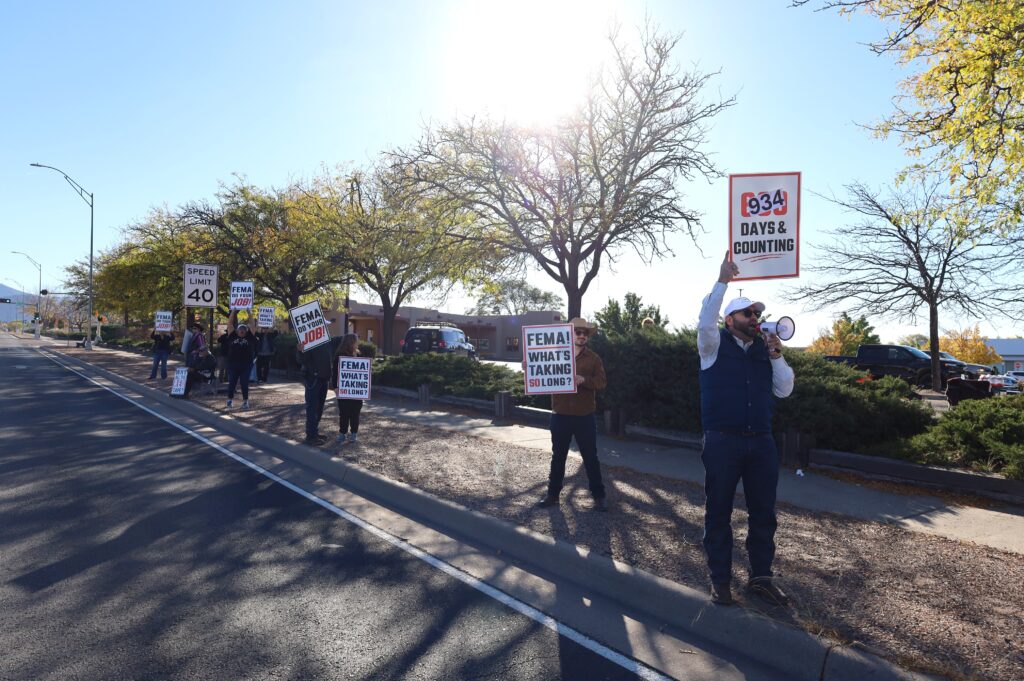
A small group of protesters drove south to Santa Fe in late October to protest in front of the main office for the Hermits Peak-Calf Canyon Fire Claims Office, frustrated with delays in payments for those who lost their homes in the fire. U.S. Martin Heinrich (D-NM) questioned FEMA leader Deanne Criswell about the issue Wednesday. (Photo by Austin Fisher/ Source NM)
U.S. Sen Martin Heinrich continued the New Mexico congressional delegation’s push to compensate victims of the state’s biggest-ever wildfire Wednesday, questioning the Federal Emergency Management Agency administrator about why people who lost everything are still waiting two years later.
The Hermits Peak-Calf Canyon Claims Office, which FEMA oversees, is in charge of paying out about $4 billion to compensate victims of the 534-square-mile wildfire that was the federal government’s fault – caused by two botched prescribed burns on federal land. The agency has paid out about $1.5 billion so far.
But Heinrich (D-NM), speaking at a Senate Appropriations Committee hearing, challenged FEMA Administrator Deanne Criswell about whether that money is going to families whose homes or livelihoods were destroyed by the fire. The delegation has repeatedly called on FEMA to make payments more quickly and make the program fairer.
“What can FEMA do differently so that the folks who literally lost everything in the fire are not the last to get their compensation?” he asked.
Criswell responded that the office has increased its staffing throughout the year and that payments have increased as a result.
“But we know we have more work to do. We continue to bring in our staffing and ensure that we have the right amount of people, the right amount of resources,” Criswell said.
Internal FEMA smoke map shows large area where northern NM residents need little to prove losses
Claims from people who lost their homes tend to be more complicated and individualized, which means they take more work from more staff to process, Criswell said. That’s where the increased staffing has helped, she said.
It’s not clear how many people who lost their primary residences are still waiting for compensation from the fund. Several hundred homes were lost in the fire. About 145 households qualified for FEMA housing assistance in the fire’s aftermath, which meant their primary residences were destroyed or unliveable.
The office has not provided that figure to Source New Mexico despite multiple requests. And, according to a Heinrich spokesperson, it also has not given it to members of New Mexico’s congressional delegation.
The delegation sent a letter Nov. 1 asking for that figure and for answers to 12 other questions about the status of the claims process, citing some progress but saying “improvements to the Claims Office’s processes and best practices are still sorely needed.”
The letter also asked the claims office how it was handling fair compensation for “culturally and structurally unique” losses, including adobe homes, and how it was ensuring food loss payments are made equitably. A recent Source New Mexico story revealed the office pays men more than women for food lost in the fire.
The food-payment issue and perceived lack of payments to those who lost their homes were among the reasons a small group of protesters gathered in late October in front of the FEMA headquarters. They called on the agency to prioritize total losses before paying out other types of damage.
As of late September, the office had paid out around $400 million in claims to about 4,200 people and businesses for smoke damage, a process the claims office designed to be quick and simple and one that applies to a roughly 2,200-square-mile area around the burn scar.
The rest of the $1.5 billion spent so far has gone to local governments, including $100 million to the City of Las Vegas, N.M., to replace its drinking water system, as well as for reforestation on private land and to businesses, nonprofits and tribal governments.
Claims office pays men more than women for food lost in state’s biggest wildfire
A FEMA spokesperson did not respond to a request for comment Wednesday.
$1.5 billion more pending
Criswell’s appearance comes as President Joe Biden is seeking Congress’ approval on a package of disaster-related funding, including $40 billion to FEMA, as his presidency comes to an end.
Included in that $40 billion request is $1.5 billion for the Hermits Peak-Calf Canyon Fire victims. If approved, that would mean the victims were awarded $5.45 billion in compensation for the 340,000-acre wildfire, minus administrative costs.
Heinrich asked Criswell what the additional money would be needed for.
Criswell said she’d seen an “independent actuarial report” that showed the total losses to the fire exceeded $5 billion. So, while she said her office can pay the claims that have been submitted to date, the claims office needs the extra money to pay what it expects future claims will cost.
Without the additional funding, “I will not be able to meet the claims down the road based on what I believe is an accurate report from this independent actuary,” she said.
A claims office spokesperson did not immediately respond to a request for the independent report. Heinrich’s office deferred comment to FEMA.

